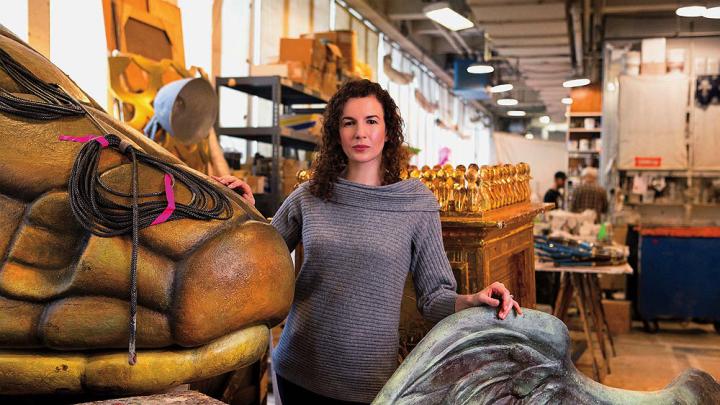On an August evening at Brooklyn’s Green-Wood Cemetery, having hiked past the lawn concert of dirgeful folk music—an audience of couples propped against each other as though they had renounced their spines—opera director Sarah Ina Meyers ’02, composer Gregg Kallor, and lighting designer Tláloc López-Watermann awaited the cemetery patrol car that would deposit them at the Catacombs. Minutes later Meyers, whose hoodie, featuring a print of wings on the back, gave her the appearance of an off-duty angel, was peering into the damp, 150-year-old vaults with a flashlight. In two months’ time, this would be the location for Kallor’s operatic settings of Frankenstein and “The Tell-Tale Heart.”
Most opera audiences sit at some remove from the action on stage. The world of the opera, such an arrangement implies, is distinct from the world beyond. The catacombs, however, make that division marginal, putting the audience just feet from the performers—and the interred. To be inside is to forget the outside, which was exactly what Meyers—slinking down the length of the central tunnel, obscured save for the lamp in her hands—was after.
This was not, as Kallor quipped, her “first rodeo in a crypt.” (Two years earlier, he had asked her to direct his setting of Poe’s horror storyin a crypt in Harlem.) Meyers, a director at the Metropolitan Opera since 2006, thrives in the dark. For her, the dark is more than just the absence of light—it is also the presence of what lies beyond the mind’s grasp. Her staging of “Tell-Tale” features multiple pulsing lights encircling the space, representing a heartbeat that grows from nothing to brightness. “Sometimes I put things in, and I’m happiest if not everyone picks up on them,” she says. “I think it affects them whether or not they know it.”
Meyers encountered the darkness early, reading “The Tell-Tale Heart” when she was around nine. It terrified her, “chang[ing] the energy around me.” While earning her 2016 Ph.D. in theatre at Columbia, she dissected the term for what she had felt upon finishing Poe’s tale: the uncanny—the physical sensation that the mind is at a loss, occurring when the boundary between reality and fantasy is shown to be permeable.
For Meyers, opera has been a means of examining the uncanny into adulthood. She describes working on certain productions as akin to being possessed by them. “Some shows…elevate me, but I work on others that literally start to infect my daily life”—like Alban Berg’s Wozzeck. “There is so much unnecessary suffering, so much hurt…I really think that it starts to reprogram my brain a bit.”
When Meyers was 14, her parents took her to the Met’s performance of Madama Butterfly. They suspected their daughter, a self-described “emotional addict,” might enjoy herself. Afterward, she says, “I couldn’t speak. I felt that my soul had been lit on fire.” She considered a conservatory education in performance, but chose Harvard for the Dunster House (now Harvard) Opera program that she could explore alongside her academic coursework.
Stage fright led her away from the spotlight and toward a directing class with the American Repertory Theater’s Marcus Stern, where she discovered her love of working backstage. During her double concentration in music and philosophy, she directed six operas. “I ended up in the field because I refused to make a choice,” she recalls. “I didn’t want to just be in theater. I didn’t want to stop reading about [other subjects]. Opera kept the door to my curiosity as widely open as possible.”
After Harvard, Meyers began a directing internship at Wolf Trap Opera Company, a launchpad for emerging artists; next came an assistantship with Francesca Zambello, artistic director of the Washington National Opera and Glimmerglass Festival. She received her first call from the Met in 2004, but a scheduling conflict forced her to turn the company down. In 2005, the Met called again, this time about assisting Julie Taymor on her non-Met opera Grendel. She began working regularly at the Met in 2006. Six days a week and sometimes more, she is on call for her dream job, but she also takes on freelance projects, including Kallor’s operas.
To direct, after a fashion, is not only to be possessed by, but also to possess the work at hand. For Meyers, that process of leaving her mark resembles an “archaeological dig” through text, music, and character. She says of working on classics like Marriage of Figaro that“creating something new when you have that much cultural memory weighing on you is hard. But there’s something to be said for experience, because over the course of those 15 versions [of Figaro], you learn a great deal.”
With new operas, she explains, “I have a strong obligation to help [composers] achieve their vision, because it’s the first iteration anyone will ever see.” Before Kallor’s operas could open at Green-Wood, Meyers needed to untangle a few knots. The catacombs lack electricity, making lighting difficult. Their structure is unfriendly to easy entry and exit—most bodies that enter are there for an extended stay—so she had to devise ways to go in and out safely. But the challenges are the price for an apt, adaptable space. In the novel, Frankenstein’s monster is assaulted by light and sound at birth; the gloomy catacombs will enable Meyers to give her audience a taste of that. “The environment needs to be an integral part of the story, an equal character,” she explains. “Directing this show in the right way, we’ll bring the fantastical around every person who will see it.”
By any given opening night, a reluctant Meyers has stopped tinkering—the show is what it is. She’s sitting way in the back of the space, or even standing, in case she needs to leave. “I clench my seat and make all sorts of funny noises as the show is happening, to the extent that my husband won’t sit next to me anymore.” Nobody is paying her any mind, though. A story is happening on stage, with designs on following them home.







